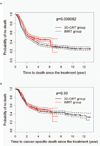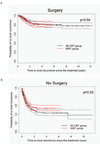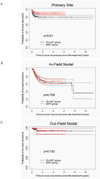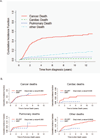Propensity score-based comparison of long-term outcomes with 3-dimensional conformal radiotherapy vs intensity-modulated radiotherapy for esophageal cancer - PubMed (original) (raw)
Comparative Study
Propensity score-based comparison of long-term outcomes with 3-dimensional conformal radiotherapy vs intensity-modulated radiotherapy for esophageal cancer
Steven H Lin et al. Int J Radiat Oncol Biol Phys. 2012.
Abstract
Purpose: Although 3-dimensional conformal radiotherapy (3D-CRT) is the worldwide standard for the treatment of esophageal cancer, intensity modulated radiotherapy (IMRT) improves dose conformality and reduces the radiation exposure to normal tissues. We hypothesized that the dosimetric advantages of IMRT should translate to substantive benefits in clinical outcomes compared with 3D-CRT.
Methods and materials: An analysis was performed of 676 nonrandomized patients (3D-CRT, n=413; IMRT, n=263) with stage Ib-IVa (American Joint Committee on Cancer 2002) esophageal cancers treated with chemoradiotherapy at a single institution from 1998-2008. An inverse probability of treatment weighting and inclusion of propensity score (treatment probability) as a covariate were used to compare overall survival time, interval to local failure, and interval to distant metastasis, while accounting for the effects of other clinically relevant covariates. The propensity scores were estimated using logistic regression analysis.
Results: A fitted multivariate inverse probability weighted-adjusted Cox model showed that the overall survival time was significantly associated with several well-known prognostic factors, along with the treatment modality (IMRT vs 3D-CRT, hazard ratio 0.72, P<.001). Compared with IMRT, 3D-CRT patients had a significantly greater risk of dying (72.6% vs 52.9%, inverse probability of treatment weighting, log-rank test, P<.0001) and of locoregional recurrence (P=.0038). No difference was seen in cancer-specific mortality (Gray's test, P=.86) or distant metastasis (P=.99) between the 2 groups. An increased cumulative incidence of cardiac death was seen in the 3D-CRT group (P=.049), but most deaths were undocumented (5-year estimate, 11.7% in 3D-CRT vs 5.4% in IMRT group, Gray's test, P=.0029).
Conclusions: Overall survival, locoregional control, and noncancer-related death were significantly better after IMRT than after 3D-CRT. Although these results need confirmation, IMRT should be considered for the treatment of esophageal cancer.
Copyright © 2012 Elsevier Inc. All rights reserved.
Conflict of interest statement
Disclaimers: The authors have no conflicts of interest to report.
Figures
Figure 1. Overall and disease-specific survival of 3DCRT and IMRT treated patients
A. IPW adjusted Kaplan-Meier estimates of the overall survival time curves, with 95% confidence intervals. B. IPW adjusted Kaplan-Meier estimates of cancer-specific survival, with 95% confidence intervals. C. IPW adjusted Kaplan-Meier estimates of the LRR free survival curves, with 95% confidence intervals. D. IPW adjusted Kaplan-Meier estimates of the distant metastatic free survival curves, with 95% confidence intervals.
Figure 1. Overall and disease-specific survival of 3DCRT and IMRT treated patients
A. IPW adjusted Kaplan-Meier estimates of the overall survival time curves, with 95% confidence intervals. B. IPW adjusted Kaplan-Meier estimates of cancer-specific survival, with 95% confidence intervals. C. IPW adjusted Kaplan-Meier estimates of the LRR free survival curves, with 95% confidence intervals. D. IPW adjusted Kaplan-Meier estimates of the distant metastatic free survival curves, with 95% confidence intervals.
Figure 2. Local-regional recurrence in 3DCRT and IMRT treated patients stratified according to surgery
A. IPW adjusted Kaplan-Meier estimates of the LRR time in the patients who had surgery after chemoradiotherapy. B. IPW adjusted Kaplan-Meier estimates of the LRR time in definitively treated patients with chemoradiotherapy.
Figure 3. Comparison of radiation technique in the patterns of local-regional failure in the definitively treated esophageal cancer patients
IPW adjusted Kaplan-Meier estimates of the time-to-recurrence in the A) primary, B) in-field nodal, or C) outfield nodal disease sites.
Figure 4. Cumulative Incidence Function for all cause mortalities of 3DCRT and IMRT treated patients
A. Overall cumulative incidence function for the various causes of deaths. B. Cumulative incidence function of each death type for the two treatment groups.
Similar articles
- Intensity-Modulated Radiotherapy versus Three-Dimensional Conformal Radiotherapy in Definitive Chemoradiotherapy for Cervical Esophageal Squamous Cell Carcinoma: Comparison of Survival Outcomes and Toxicities.
Chen NB, Qiu B, Zhang J, Qiang MY, Zhu YJ, Wang B, Guo JY, Cai LZ, Huang SM, Liu MZ, Li Q, Hu YH, Li QW, Liu H. Chen NB, et al. Cancer Res Treat. 2020 Jan;52(1):31-40. doi: 10.4143/crt.2018.624. Epub 2019 Apr 30. Cancer Res Treat. 2020. PMID: 31048664 Free PMC article. - Effect of radiotherapy techniques (IMRT vs. 3D-CRT) on outcome in patients with intermediate-risk rhabdomyosarcoma enrolled in COG D9803--a report from the Children's Oncology Group.
Lin C, Donaldson SS, Meza JL, Anderson JR, Lyden ER, Brown CK, Morano K, Laurie F, Arndt CA, Enke CA, Breneman JC. Lin C, et al. Int J Radiat Oncol Biol Phys. 2012 Apr 1;82(5):1764-70. doi: 10.1016/j.ijrobp.2011.01.036. Epub 2011 Apr 4. Int J Radiat Oncol Biol Phys. 2012. PMID: 21470795 Free PMC article. Clinical Trial. - Propensity score-based comparison of survival and radiation pneumonitis after definitive chemoradiation for esophageal cancer: Intensity-modulated radiotherapy versus three-dimensional conformal radiotherapy.
Lan K, Zhu J, Zhang J, Zhou S, Yang Y, Feng Z, Zhang L, Wang S, Xi M. Lan K, et al. Radiother Oncol. 2020 Aug;149:228-235. doi: 10.1016/j.radonc.2020.05.036. Epub 2020 May 29. Radiother Oncol. 2020. PMID: 32474127 - IMRT vs. 2D-radiotherapy or 3D-conformal radiotherapy of nasopharyngeal carcinoma : Survival outcome in a Korean multi-institutional retrospective study (KROG 11-06).
Moon SH, Cho KH, Lee CG, Keum KC, Kim YS, Wu HG, Kim JH, Ahn YC, Oh D, Lee JH. Moon SH, et al. Strahlenther Onkol. 2016 Jun;192(6):377-85. doi: 10.1007/s00066-016-0959-y. Epub 2016 Mar 14. Strahlenther Onkol. 2016. PMID: 26972085 Review. English. - Comparison of IMRT versus 3D-CRT in the treatment of esophagus cancer: A systematic review and meta-analysis.
Xu D, Li G, Li H, Jia F. Xu D, et al. Medicine (Baltimore). 2017 Aug;96(31):e7685. doi: 10.1097/MD.0000000000007685. Medicine (Baltimore). 2017. PMID: 28767597 Free PMC article. Review.
Cited by
- Concurrent chemoradiotherapy versus radiotherapy alone for patients with locally advanced esophageal squamous cell carcinoma in the era of intensity modulated radiotherapy: a propensity score-matched analysis.
Li C, Tan L, Liu X, Wang X, Zhou Z, Chen D, Feng Q, Liang J, Lv J, Wang X, Bi N, Deng L, Wang W, Zhang T, Ni W, Chang X, Han W, Gao L, Wang S, Xiao Z. Li C, et al. Thorac Cancer. 2021 Jun;12(12):1831-1840. doi: 10.1111/1759-7714.13971. Epub 2021 May 5. Thorac Cancer. 2021. PMID: 33949784 Free PMC article. - Racial and Ethnic Health Disparities in Delay to Initiation of Intensity-Modulated Radiotherapy.
Hutten RJ, Weil CR, Gaffney DK, Kokeny K, Lloyd S, Rogers CR, Suneja G. Hutten RJ, et al. JCO Oncol Pract. 2022 Oct;18(10):e1694-e1703. doi: 10.1200/OP.22.00104. Epub 2022 Aug 5. JCO Oncol Pract. 2022. PMID: 35930751 Free PMC article. - Heart and lung doses are independent predictors of overall survival in esophageal cancer after chemoradiotherapy.
Xu C, Guo L, Liao Z, Wang Y, Liu X, Zhao S, Wang J, Yuan Z, Wang P, Lin SH. Xu C, et al. Clin Transl Radiat Oncol. 2019 Apr 24;17:17-23. doi: 10.1016/j.ctro.2019.04.016. eCollection 2019 Jul. Clin Transl Radiat Oncol. 2019. PMID: 31080898 Free PMC article. - Setup errors in radiation therapy for thoracic tumor patients of different body mass index.
Zhao J, Zhang M, Zhai F, Wang H, Li X. Zhao J, et al. J Appl Clin Med Phys. 2018 May;19(3):27-31. doi: 10.1002/acm2.12270. Epub 2018 Mar 1. J Appl Clin Med Phys. 2018. PMID: 29493070 Free PMC article. - Tumor-Derived Exosomal miR-143-3p Induces Macrophage M2 Polarization to Cause Radiation Resistance in Locally Advanced Esophageal Squamous Cell Carcinoma.
Gao LR, Zhang J, Huang N, Deng W, Ni W, Xiao Z, Liu M. Gao LR, et al. Int J Mol Sci. 2024 May 31;25(11):6082. doi: 10.3390/ijms25116082. Int J Mol Sci. 2024. PMID: 38892269 Free PMC article.
References
- ACS. Esophageal Cancer. Cancer Statistics; 2010. www.cancer.org/acs/groups/content/.../esophagealcancerpdf.pdf.
- Fenkell L, Kaminsky I, Breen S, et al. Dosimetric comparison of IMRT vs. 3D conformal radiotherapy in the treatment of cancer of the cervical esophagus. Radiotherapy and Oncology. 2008;89:287–291. - PubMed
- Chandra A, Guerrero TM, Liu HH, et al. Feasibility of using intensity-modulated radiotherapy to improve lung sparing in treatment planning for distal esophageal cancer. Radiotherapy and Oncology. 2005;77:247–253. - PubMed
- Nutting CM, Bedford JL, Cosgrove VP, et al. A comparison of conformal and intensity-modulated techniques for oesophageal radiotherapy. Radiotherapy and Oncology. 2001;61:157–163. - PubMed
- Wu VWC, Kwong DLW, Sham JST. Target dose conformity in 3-dimensional conformal radiotherapy and intensity modulated radiotherapy. Radiotherapy and Oncology. 2004;71:201–206. - PubMed
Publication types
MeSH terms
LinkOut - more resources
Full Text Sources
Other Literature Sources
Medical
Research Materials



